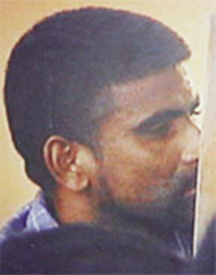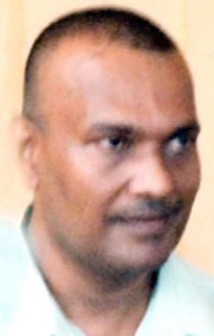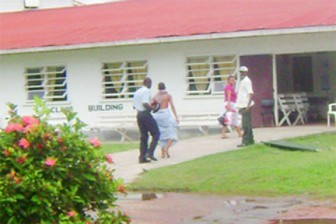‘…the facts in this case disclose a horrendous account of torture and inhuman or degrading treatment which ground my decision for finding that there has been a violation of (the boy’s) human rights generally to be treated with dignity and respect as a child and as a person. In my opinion, therefore the torture and cruel and inhuman treatment meted out to (the boy) has demonstrated and established an absolute and flagrant disregard for his constitutional rights’
Justice Roxane George described the case of the 14-year-old whose genitals were burnt in a police station in 2009 as constituting torture and she ruled on Friday that there had been a violation of his fundamental human rights.
The decision by the judge formally defining his treatment as torture is seen as important as the lower court case had collapsed without a ruling. Her recourse to international human rights law and treaties is also seen as having wider implications.

In her ruling, the judge said the case discloses a horrendous account of torture and inhuman or degrading treatment, referencing the threats; the stripping almost to nakedness; the beatings; the poor state of the place of detention; the burning of his genitals and the delayed medical attention, among other things.
Justice George awarded $6.5 million in damages to the teen whose mother had filed a lawsuit against the Attorney General, the Commissioner of Police, Sergeant Narine Lall and Constable Mohanram Dulai.
The judge awarded compensatory damages to the boy totalling $4.5 million and in addition, she awarded $2 million in exemplary damages “to reflect the sense of public outrage, to emphasise the importance of the constitutional right and gravity of the breach and deter further breaches”.
Justice George handed down a 36-page judgment which addressed various issues tied to the case including unlawful detention, mistreatment and damages.

The judge found that there has been no accountability on the part of any of the respondents in relation to the claims made by the boy, but observed that Crime Chief Seelall Persaud, in his affidavit in answer, was hard-pressed to deny any of the specific allegations made against the police ranks given the overwhelming evidence.
The judge described Persaud’s affidavit as non-committal. He deposed that he had no knowledge of the averments contained in the boy’s affidavit of the treatment he had endured in police custody. He further deposed that the motion for constitutional redress was premature as the police ranks Sergeant Lall and Detective Constable Dulai were criminally charged and were to be presumed innocent until proven guilty.
She noted that Persaud then went on to say that as far as he was aware the police force did not sanction torture and that the force discharges its lawful duty by ensuring that ranks are adequately and appropriately trained in the performance of their duties.

Said the judge: “It is unclear what aspect of the applicant’s claim these assertions are meant to address. The fact that the Guyana Police Force does not at all sanction or facilitate the use of torture or force or threats of the use of force does not mean that such misconduct on the part of ranks and officers does not occur. The criminal assizes, for instance, are replete with allegations in these regards and many of them have been found by the courts to have merit. Further, the fact also that there is the training of ranks and officers as detailed does not mean that all ranks abide by the training and uphold the laws that they are mandated to follow and carry out”.
The boy was 14 years plus when he was arrested and was considered a juvenile or a young person under the Juvenile Offenders Act. Justice George referred to the force as a public institution which is specifically mandated to uphold the best interests of children, and in this case had to uphold the best interest of the boy as a child in custody.
Motto
But nothing in the affidavit in answer addressed the fact that the detainee was a child and had to be treated as such, she noted. She said given the boy’s age and consequential added vulnerability, and that he was being detained by police officers who according to the motto of the force are to provide ‘Service and Protection’; the entire episode must have caused Thomas and would continue to cause him serious cruel suffering and psychological trauma.

She cited the Judges’ Rules which say that as far as practicable children should be interviewed in the presence of a parent or guardian and articles 37 and 40 of the Convention on the Rights of the Child which speak about the unlawful deprivation of the liberty of a child and undignified treatment.
The Judge pointed out that the boy was arrested at his home in the presence of a sister and there was nothing in the affidavits to indicate that he was told what he was being arrested for.
Further, there was nothing in the affidavits to indicate that any effort was made to ascertain the boy’s age and whether his parents were available to go to the station that night.
“There is nothing in the affidavit in answer to indicate any compliance with the direction in the Judges’ Rules regarding the arrest of (the boy). The facts also disclose that the Administrative Direction was not complied with as regards (the boy’s) detention. Even though he said he requested that his parents be called this was not done and it was not until 31st October, 2009, that he was able to see his mother, despite her having visited La Grange Police Station on 28th October when she left food for him but was not allowed to speak to him”, the Judge declared.
She found that the continued detention of the boy despite his injuries and even after the intervention of his lawyer, Khemraj Ramjattan and his mother, was unlawful. “How it was that the police hoped to keep such a horrendous occurrence under wraps remains a mystery”, the judge said.
“I also specifically find that the treatment of (the boy) was degrading, humiliating and debasing as it must have aroused in him fear and anguish, moreso fear of future incapacity. To my mind, by failing to provide him with any medical attention for over a day after he was burnt, the unprofessional medical attention he received, and by failing to permit him to go to the hospital for further medical attention for another two days, they displayed a callous indifference, lack of care and an absence of concern for (the boy) as a detainee and as a child,” the judge ruled.
Justice George said there was nothing contradicting the boy’s claims and the photographs exhibited in support. “They say a picture speaks a thousand words. Unfortunately, the photographs cannot be appended to or included in this decision so that the true impact of what they disclose can be seen,” she added.
Proper parties
In addition to her findings on the affidavits, Justice George had to address the issue of whether Sergeant Lall and Constable Dulai were proper parties to the motion because Persaud had contended that they were not proper parties, and that the motion should be dismissed against them.
State Counsel Naresh Harnanan had submitted that Lall and Dulai had been criminally charged, and that the motion was misconceived, speculative, vexatious and without merit. However, the court said that counsel cited no authority or legal reasoning in support of his submissions.
Justice George disagreed with the submission that only the Attorney General could have been a party to the proceedings and she cited the authorities including Ramson v Barker and Anor (1982) WIR 183 where both the Commissioner of Police and the Attorney General were sued by way of a constitutional motion for breaches of the fundamental rights of the appellant by ranks and officers of the Guyana Police Force.
She did however rule that the Commissioner of Police was not a proper party to the action and the case against him was dismissed but said that given the human rights context and milieu the time had likely arrived for a review of whether the Commissioner of Police should also be a party to constitutional proceedings such as these in respect of vicarious liability for the misconduct of members of the force. She posited that this would hopefully contribute to a realization of the heavy burden of upholding the human rights of individuals.
In relation to Lall and Dulai, the Judge said, “I am of the view that there should be a new dispensation that should allow persons and entities who are State actors to be named in constitutional motions as parties so that they can be held jointly and severally culpable along with the state if liability is found. This would obviate the necessity for a multiplicity of actions e.g. in a suit against the actors personally for damages in tort,” the judge said.
She continued that this would also allow for the proper appointment of blame for wrongdoing against such actors who would then be unable to easily shelter their misconduct behind the Attorney General and the State, “which of course may involve a charge on taxpayers through any damages awarded against the State, with the distinct possibility that they may feel that there may be no direct sanction or consequences for their misdeeds and that they can act with impunity, criminal proceedings notwithstanding, for not all misconduct by State actors would necessarily involve the institution of criminal proceedings.”
Expounding on the legal principles applied in her decision, she noted that Article 39 (2) stated that “In the interpretation of the fundamental rights provisions in this Constitution a court shall pay due regard to international law, international conventions, covenants and charters bearing on human rights”. She also cited Article 154 in this respect and then adverted to the Convention on the Rights of the Child, the International Covenant on Civil and Political Rights and the Convention Against Torture and Other Inhuman or Degrading Treatment or Punishment which are encompassed in the fourth schedule referred to by the article.
Incorporated
“It is clear that the incorporated international human rights provisions in Guyana are not merely persuasive and that the judiciary has to be constantly cognizant of these provisions. This specific mandate gives the court jurisdiction and makes it an obligation of the court to incorporate international human rights law into the domestic law of Guyana when interpreting the rights provisions of the constitution. It is a mandate and jurisdiction which must be taken seriously and actively applied where relevant”, the judge declared.
Citing several authorities as she considered the constitutional proceedings, the judge also said that in her view for a court to uphold the postulate of Persaud in his affidavit on behalf of Lall, Dulai and the Attorney General that the prospect of criminal liability would be sufficient “would be a dereliction of the duty and responsibility of the Court as mandated by the Constitution of Guyana, more particularly art 153, where an applicant has sought to invoke the guarantees outlined in the Constitution and redress provided therein”.
She further contended that there has to be a distinction between action by the state by the institution of criminal proceedings and action against the state by an individual relevant to the same criminal proceedings.
“…while the State has an obligation, based on evidence, to prosecute persons according to law for criminal offences, redress does not and cannot only include criminal liability of the individuals and can include other forms of tangible redress against the state whether by an action for damages or through redress pursuant to article 153 of the Constitution”.
She noted that State counsel Harnanan’s concern that the constitutional motion should be stayed or dismissed pending the outcome of the criminal proceedings as any ruling might be prejudicial to the policemen had been overtaken by the collapse of the case in the magistrate’s court for want of prosecution.
While she said the motion could possibly have been stayed pending the outcome of the criminal proceedings, the judge said she was of the view applying international human rights principles “that to hold that it be dismissed would make the court, the judicial branch of the State, complicit in the violation of the (boy’s) human rights as enshrined in the fundamental rights under which he makes his claim”.
She added that a failure on the part of the judiciary to uphold human rights norms would amount to a failure live up to its international obligations.
The judge then cited various authorities and arguments for redress and monetary compensation
In her orders she found that the state in the form of the Attorney General had violated the fundamental rights of the applicant as guaranteed by articles 139 and 141 not only in relation to Lall and Dulai but also in relation to other members of the police force who did little or nothing to address his plight and in relation to the police surgeon Dr Mahendra K. Chand “who compounded the violations by what I consider to be a lack of sensitivity and professionalism”. Dr Chand had examined the boy while the boy had a hood over his head and did not ensure that he was immediately taken for medical treatment.
She also found that Lall and Dulai had violated the fundamental rights of the applicant in respect of articles 139 and 141. A total of $6.5M in damages was awarded against the AG, Dulai and Lall.
Earlier in her ruling the judge had said “…the facts in this case disclose a horrendous account of torture and inhuman or degrading treatment which ground my decision for finding that there has been a violation of (the boy’s) human rights generally to be treated with dignity and respect as a child and as a person. In my opinion, therefore the torture and cruel and inhuman treatment meted out to (the boy) has demonstrated and established an absolute and flagrant disregard for his constitutional rights”.





